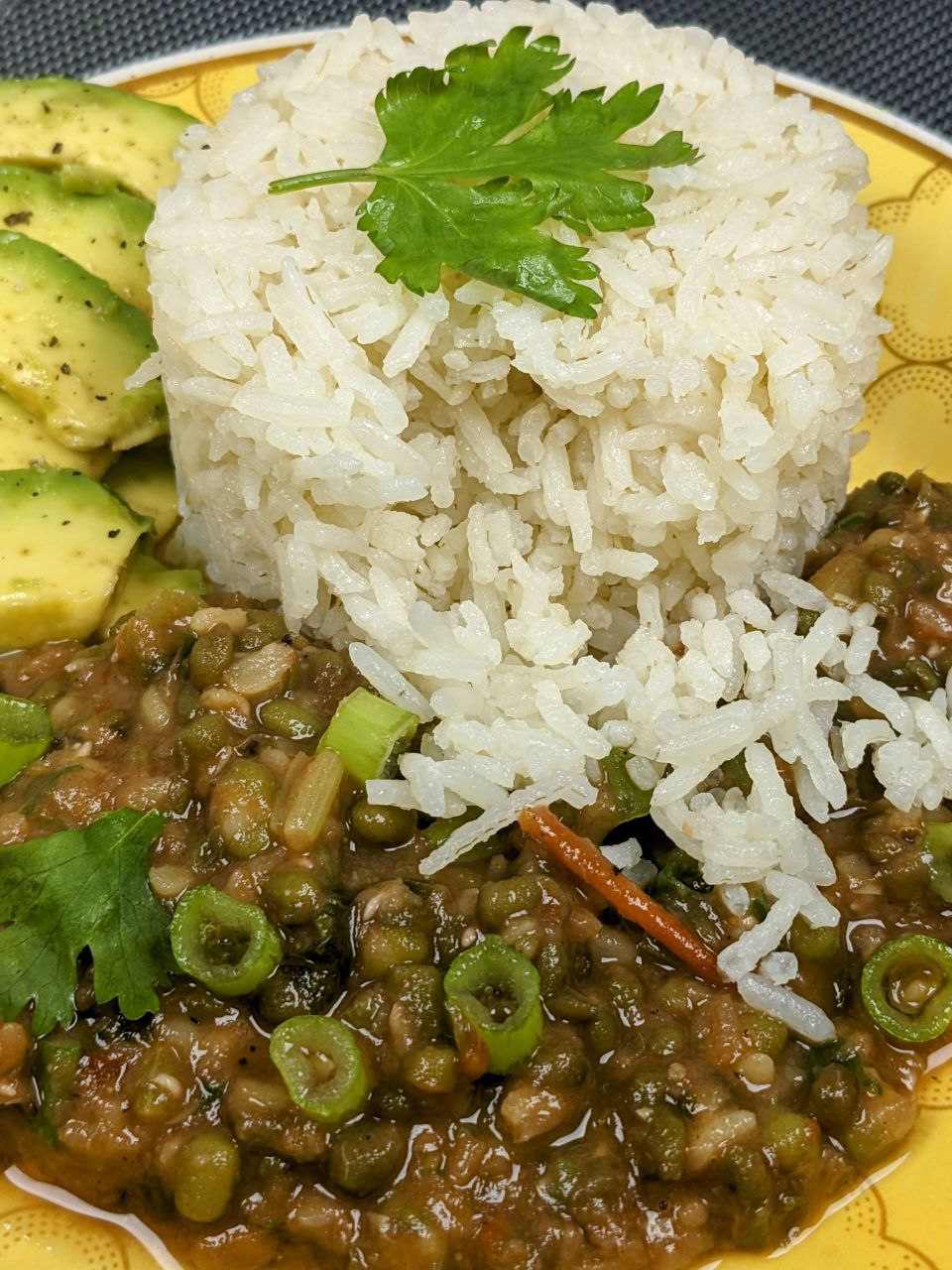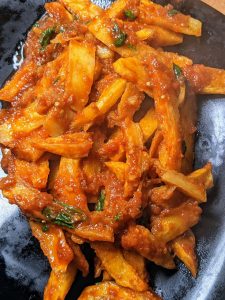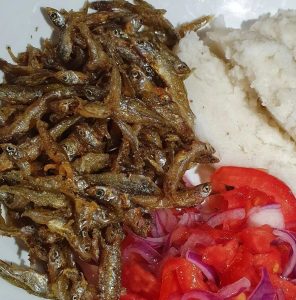Rice ndengu is a dish combination of green grams(mung beans) locally known as ndengu in Kenya, with steamed white rice. Ndengu goes best with rice, the other next thing I can think of is chapatis, this post is a recipe on how to cook up and serve rice ndengu using as few ingredients as possible that you already have in your kitchen and still make it taste great.
Ingredients
Some ingredients are listed as optional so feel free to skip those if you do not have them at hand
For Rice
- 1 Cup Basmati/ Pishori Rice
- 1 Tbs Vegetable Oil
- A Pinch of Salt
For Ndengu
- 1 Cup Dried Green Grams
- 2 Tbs Vegetable Oil
- 2 Cups Water
- 1 Onion
- 1 Tomato
- 1 Bunch, Dhania (Fresh Corriander)
- 3 Cloves, Garlic (OPTIONAL)
- 1 Tsp, Garam Masala (OPTIONAL)
- 1 Tsp, Curry Powder (OPTIONAL)
If you got your ndengu from the market, be sure to sort through it to remove any impurities like stones, which you definitely don’t want to bite into. If you bought a packet from the supermarket, the cleaning and sorting have already been done. However, don’t just buy any brand of ndengu you find on the shelf; choose reputable brands like Pearl, Daawat, S&S, or Butterfly. These brands are reliable and I’ve personally tried them. Some lesser-known brands might not cook evenly, leaving you with some well-cooked ndengu and some that are still raw.
For the rice, go with basmati or pishori grain varieties. Jasmine rice also works well. Avoid long-grain rice as it tends to clump together unless you take extra precautions during cooking.
For rice brand recommendations then check out this post: Grocery Guide: 10 Best Rice Brands in Kenya-Ranked List
The key to perfect rice is thorough washing; otherwise, it will end up sticking together and becoming mushy like ugali. Wash the rice until the water runs clear and not white or misty, and you’ll be golden.
Let’s get to the procedure.
Procedure
- Prepare the Ndengu:
- Wash your ndengu thoroughly.
- Discard any that float and keep only those that sink to the bottom.
- Boil the ndengu until tender. If using a pressure cooker, cook for 12 minutes with a ratio of 1 cup ndengu to 3 cups water. For stovetop cooking, add water as needed when levels drop low.
- Prepare the Rice:
- While the ndengu is boiling, wash the rice until the water runs clear.
- Soak the rice in a ratio of 2 cups water to 1 cup rice for at least 10 minutes (optional step to reduce cooking time).
- Cook the Rice:
- Cook the rice with the soaked water.
- Add oil and salt, mix, and cover the pot.
- Cook on low to medium heat to avoid burning.
- Check water levels periodically and add more water as needed before it dries up.
- Once the rice is done and the water has evaporated, fluff it up and cover it for 10 minutes off the heat to let the residual heat finish cooking the rice.
- Prepare the Vegetables:
- Chop the vegetables: mince or grate the garlic, slice the onions, dice the tomatoes, and chop the dhania.
- In a pan, cook the onions in 2 tablespoons of vegetable oil until fragrant and transparent.
- Add the minced garlic and cook for less than a minute.
- Add the tomatoes and dhania stems, cooking until everything is soft and jammy.
- Combine and Cook the Ndengu Stew:
- Add the cooked ndengu to the pan and cook until everything is well-coated.
- Add about two cups of the water drained from boiling the ndengu.
- Lower the heat to low, add any dry spices as desired, and cover.
- Cook slowly until the stew reaches your desired consistency.
- Serve:
- Serve the ndengu stew with cooked rice.
- Garnish the stew with dhania leaves or freshly chopped spring onion leaves.
- Add avocado slices on the side, seasoned with pepper and salt.
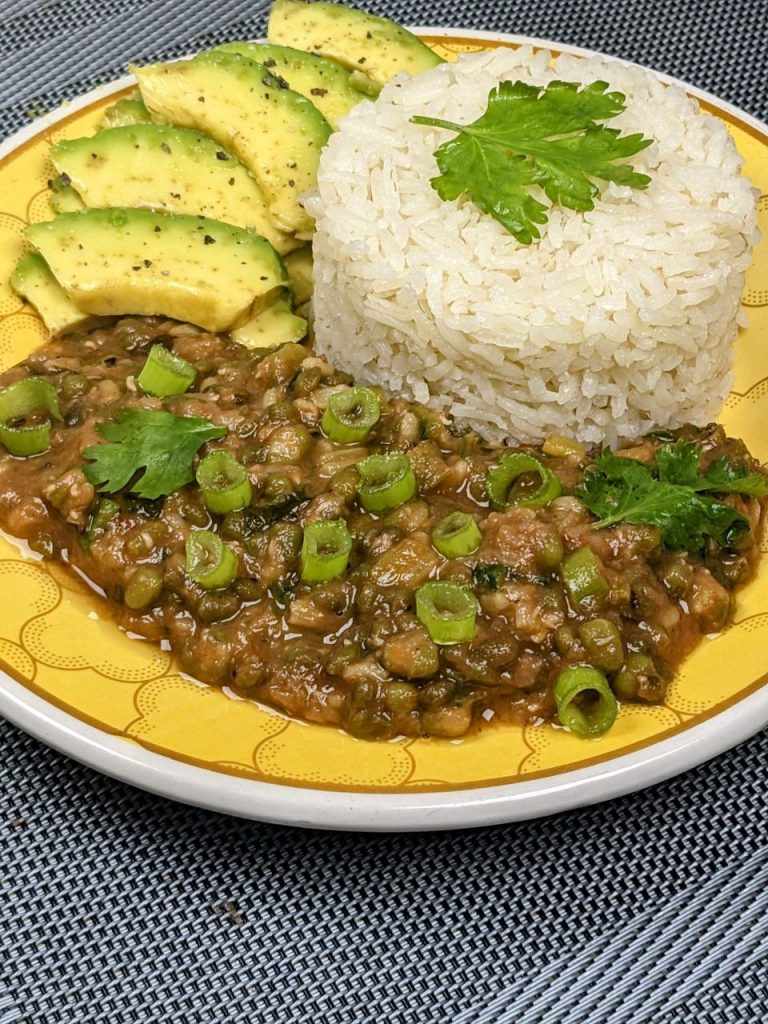
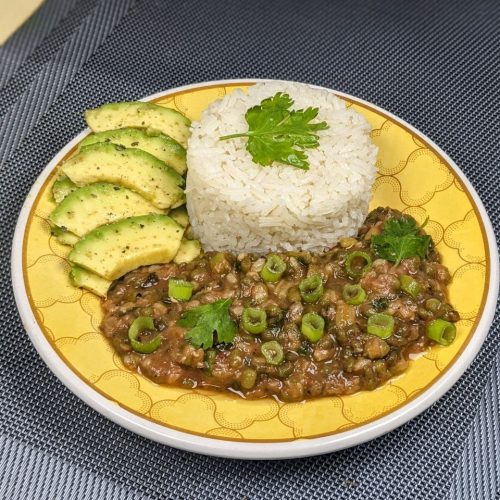
Ndengu Stew With Rice
Equipment
- 1 Pressure Cooker Optional
Ingredients
For the Rice
- 1 Cup Basmati/ Pishori Rice
- 1 Tbs Vegetable Oil
- A Pinch of Salt
For the Ndengu
- 1 Cup Dried Green Grams
- 2 Tbs Vegetable Oil
- 2 Cups Water
- 1 Onion
- 1 Tomato
- 1 Bunch Dhania (Fresh Corriander)
- 3 Cloves Garlic (OPTIONAL)
- 1 Tsp Garam Masala (OPTIONAL)
- 1 Tsp Curry Powder (OPTIONAL)
Instructions
- Sort ndengu to remove impurities like stones.
- Wash ndengu thoroughly and boil until tender (12 minutes in a pressure cooker with a 1:3 ratio of ndengu to water; for stovetop, add water as needed).
- Wash rice until water runs clear.
- Soak rice in a 2:1 ratio of water to rice for at least 10 minutes (optional).
- Cook rice with soaked water, adding oil and salt.
- Cook rice on low to medium heat, checking water levels and adding more if needed.
- Once rice is cooked, fluff it and let it rest covered for 10 minutes.
- Mince or grate garlic, slice onions, dice tomatoes, chop dhania.
- Cook onions in 1 tablespoon of oil until fragrant and transparent.
- Add garlic and cook briefly, then add tomatoes and dhania stems, cooking until soft and jammy.
- Add cooked ndengu to the pan, coat well, and add about two cups of the drained cooking water.
- Lower heat, add dry spices, cover, and cook until desired stew consistency is reached.
- Serve ndengu stew with rice.
- Garnish with dhania leaves or chopped spring onion leaves.
- Add seasoned avocado slices on the side.
Notes
- Sorting and Washing: Ensure to sort through the ndengu to remove any impurities like stones before washing them thoroughly.
- Rice Preparation: Washing the rice until the water runs clear helps remove excess starch, resulting in fluffier cooked rice. Soaking the rice beforehand can also shorten the cooking time.
- Cooking Techniques: Whether using a pressure cooker or stovetop, ensure the ndengu are cooked until tender but not mushy. Properly cooked ndengu should be soft yet retain their shape.
- Flavor Development: Sauteing onions, garlic, and spices before adding ndengu and tomatoes enhances the stew’s flavor. Adjust seasoning to taste during cooking. Also, slow cooking is important to allow flavors to marry, always use low heat
- Rice Texture: Cooking rice on low to medium heat with a lid helps achieve evenly cooked grains without burning. Letting the rice rest off the heat after cooking allows it to finish steaming and ensures a fluffy texture.
- Garnishing and Serving: Garnish the stew with fresh dhania leaves or chopped spring onions just before serving to enhance its aroma and freshness. Serve with seasoned avocado slices for added flavor.
If you’re interested or in the market of a pressure cooker then consider this post: Buying Guide: The Best Electric Pressure Cookers in Kenya
If you use basmati rice, it tends to fluff up so you will have leftover rice guaranteed, case you’re wondering what to do with it, it is time to try egg fried rice, essentially it utilizes leftover rice and eggs and a few sauces, and spring onions or shallots, be sure to check the recipe: Uncle Roger Approved Egg Fried Rice Recipe
If that is not possible, then get an avocado, mash it up, and mix it with the rice, add a little salt and seasoning, it tastes so good for being that low-effort, drizzle a lemon or lime wedge on top to get an even more broad taste
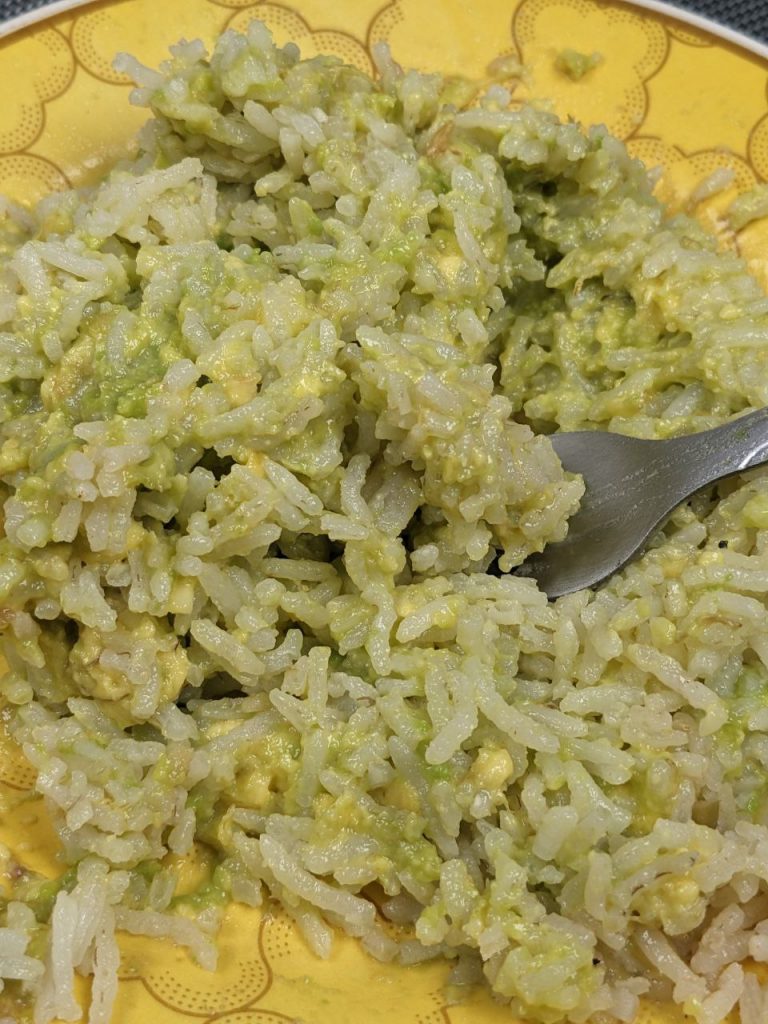
Check out another ndengu recipe utilizing coconut milk, the dish is also known as pojo: Coconut Green Grams Recipe: (Ndengu / Pojo)
Not just rice, ndengu stew also goes great with chapatis: Recipe- How to Make Chapatis (for Beginners): Step by Step
Nutritional Information
Here’s the approximate nutritional information for a serving of rice and ndengu stew:
- Calories: Around 300-350 kcal per serving
- Protein: Approximately 10-15 grams
- Carbohydrates: About 50-60 grams
- Fat: Around 5-8 grams
- Fiber: Approximately 8-10 grams
- Sodium: Varies based on seasoning; typically moderate
This nutritional profile may vary slightly depending on the specific ingredients used and serving size.

